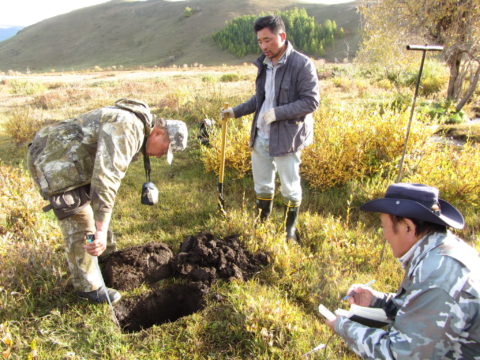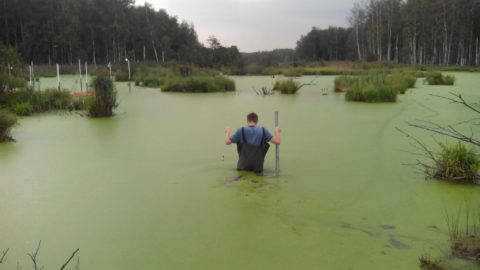
Inspiring, Mobilising, and Upscaling Action for Peatlands
-
Peatland conservation and restoration
Peatlands – and wetlands in general – are the superheroes of nature. Peatlands cover only 3% of the world’s land area, but contain 500GT of carbon – twice the carbon stock in total global forest biomass. Their conservation and restoration are essential to solving the twin crises of climate change and biodiversity loss, while also securing a healthier and more prosperous future for humanity.
Wetlands International has been among the first organisations to bring the world’s attention to peatland drainage, a huge contributor to climate change, by building alliances with key climate networks including the UNFCCC, CBD, and, of course, the Global Peatlands Initiative (GPI), to influence global agreements, promote best practices in peatland management with governments and companies, and partner on the ground with local communities to restore peatlands for the benefit of people, nature, and climate.
Repairing the Damage in Russia
The Russian Federation has around a quarter of the world’s peat bogs, covering 1.4 million square kilometres. The river floodplains around Moscow are covered in these wet, carbon-rich soils. Wetlands International first mapped and classified Russia’s peatlands in 1997, and our cooperation with national and international environmental agencies goes all the way back to 1959.
From early surveys we came to understand the damaged state of peatlands as they were drained for farmland and mined for electricity generation during the last century, then abandoned in a dried out and degraded state. During a record heatwave in the summer of 2010, wildfires on drained peatlands encircled Moscow, creating choking black smog that resulted in the deaths of thousands of people, while releasing huge amounts of greenhouse gases. This became the catalyst for one of the largest peatland ecosystem restoration projects in the world.

To stop the fires and safeguard the carbon, we tested innovative pilot projects and cost-effective rewetting techniques. The pilots were proving grounds, not only for the techniques but also for carbon benefit assessments and to test alternative crops that could thrive in wet peatlands.
The success is evident. By blocking small drainage channels, water levels have risen again, and nearly 100,000 hectares of drained peatlands have been restored, with plans to dramatically scale up the restoration to half a million hectares. The result has been the reduced risk of fires and many lives saved, as nearly 30 million people are no longer exposed to the smoke and smog. The restored sites are even becoming economically valuable again through the sustainable cultivation of wet agriculture crops while benefiting native plants and wildlife.

The restoration is also combating climate change by keeping huge amounts of carbon in the ground. The total amount of emissions reductions achieved by rewetting practices is currently estimated at 320,000 metric tonnes CO2 eq. per year. Fire prevention further reduces emissions by a similar amount.
Dianna Kopansky, who coordinates the Global Peatlands Initiative at UNEP, celebrated these significant achievements: “The success of Wetlands International’s peatland restoration initiatives in Russia truly highlight the importance of peatlands: for people, for biodiversity and for the climate. Containing such a wealth of the world’s peatlands, it is vital that restoration techniques, management best practice, and detailed data are collected and made available for Russian communities and others to learn from. This work is a great case for inspiration and the increased ambition level is an important contribution to the UN Decade on Ecosystem Restoration. These collaborative efforts highlight why peatlands are a priority ecosystem not only for restoration, but also the urgency of their conservation. It also demonstrates how productivity and conservation don’t have to be mutually exclusive.”
Our target is to safeguard intact peatlands and for 50 million hectares of drained peatlands to be rewetted by 2050 in order to reach carbon neutrality. All that we have achieved to date has been made possible through the involvement of our many corporate, government, civil society, academic and community partners. Our ambition from here is to dramatically scale up the conservation and restoration of peatlands as a contribution to climate change mitigation and adaptation, biodiversity conservation and sustainable development.
We invite you, our partners and donors, to join us and help conserve and restore the world’s peatlands.
Learn more about our work on peatlands here – https://peatlands.wetlands.org/
****************************************************************
This release is part of the Global Peat Press Project (GP3) campaign, bringing together international partners to highlight the importance of peatlands as vulnerable but valuable ecosystems. It is a coordinated media outreach from UNEP’s Global Peatlands Initiative (GPI) and the North Pennines AONB Partnership to promote the UN Decade on Ecosystem Restoration (2021-2030). It was conceived to raise awareness and enthusiasm about the role of peatlands in climate action in the run-up to the UNFCCC COP26 in November, and has now pivoted to focus on the vital importance of peatlands for nature, aiming to build momentum and interest in advance of the Convention on Biological Diversity (CBD) COP15 in April 2022.
A relay of stories from peatland projects worldwide, GP3 started with the UK, as the host of COP26, which took place in Glasgow, Scotland. The relay has already featured:
– The North Pennines AONB – The Care-Peat project in Belgium – NUI Galway/ Insight Centre – Five EU transnational projects (Carbon Connects, Care-Peat, DESIRE, LIFE Peat Restore, and CANAPE) – Bax & Company who straddle the UK, Spain and The Netherlands – Ulster Wildlife – The Lancashire Wildlife Trust – The GPI and EUROSITE Peatlands Social Media Campaign – NABU – Moors for the Future Partnership – Metsähallitus with its Hydrology LIFE Project – Natural Resources Wales with the LIFE Welsh Raised Bogs Project – Community Wetlands Forum and the Landscape Finance Lab – Terra Motion – Green Restoration Ireland Coop (GRI) – a major restoration effort in Belarus recognized by the Ministry of Natural Resources and Environmental Protection of the Republic of Belarus – a second release from Ulster Wildlife – The World Conservation Monitoring Centre (WCMC) at the UN – Griefswald Mire Centre in Germany – Conservatoires d’éspaces naturels in France – the Cairngorms National Park, Scotland – a second contribution from the North Pennines AONB – CINEA – LIFE – Baltic Environmental Forum Lithuania – Yorkshire Peat Partnership – APB-BirdLife Belarus – Frankfurt Zoological Society – Tompkins Conservation and Rewilding Argentina
…and now the baton is held by Wetlands International.
Join us – share, learn, inspire, experience, and act for peatlands, people, and the planet. Follow and share using #PeatlandsMatter and #GenerationRestoration.
